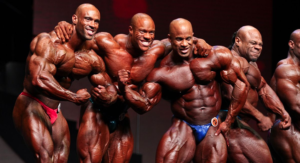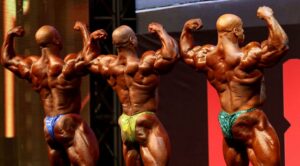To look like a bodybuilder you have to train like one.

The Bodybuilding Basics for Total Beginners
Start sculpting your best physique with tips from legendary bodybuilder Ric Drasin.
IDEAS AND EXPERIMENTATION
Along the way, there have been many variations to the basic bodybuilding approach to training that have been introduced. Arthur Jones, who created the Nautilus machine, advocated for super-intense workouts on machines, with high resistance, low reps, few sets, and lots of techniques such as negative repetitions and forced negatives. At the other end of the spectrum, there have been advocates for high volume training such as doing 100 rep sets as well as supersets and giant sets. Others besides Jones advocated reliance mostly on machines and we’ve seen many variations of exercise devices that provided resistance from water, compressed air, and even computer-controlled friction.
Nonetheless, if you look at today’s top bodybuilders they are bigger, harder, and more defined than any time before in history, and while their training programs are not identical there is a remarkable similarity. They almost all do variations of programs that seem to tap into the fundamental nature of the body and its muscles and produce the most dramatic results. They have discovered in what ways you have to train if you want to look like a bodybuilder.
Almost anyone who reads physique magazines or spends any time working out in a serious gym knows how a basic bodybuilding program works. But it seems relatively few understand why it works. And achieving this basic understanding is very helpful when it comes to introducing variations in your own workouts that keep your interest at its maximum without reducing the effectiveness of your training.
- THE FUNDAMENTALS OF BODYBUILDING
One of the most fundamental aspects of a training program is sets and reps. How many reps should you do of how many sets and how much weight should be involved. Again, most experienced bodybuilders know that the traditional approach which has worked for many champions is the following:
- 4 to 5 sets of 4 to 5 exercises
- 8 to 12 sets for upper body
- 12 to 16 for lower body
- Approximately 75% of one-rep max resistance
Like everyone else, I understood this to be the best basic approach to training early on but didn’t understand the underlying principles as to why this worked so well. Then I spoke to Dr. Fred Hatfield – Dr. Squat – and he introduced me to the idea of time under tension. And that made a lot of things clear.
When you exercise a muscle you don’t change it directly — unless of course you are creating damage to the tissue. Training sends signals through the nervous system that inform the body it is under physical stress and needs to respond and adapt. If you were to overload a machine it would burn out. If you overload the body — by just the right amount — it increases its capacity.
The idea of specificity of training centers on the fact that the body doesn’t care what you think you are asking it to do. It responds directly to the physical stimulus you create. So what bodybuilders have done over the decades is uncover what is in effect the underlying computer code of the body, the software that governs how it responds to physical demand.
-
TIME UNDER TENSION
Time Under Tension is a measure of how much resistance a muscle contracts again and how long it remains subject to this resistance. For the most part, a single standard rep of an exercise will be about 1 second. So doing 10 reps your muscles will be under tension for 10 seconds. While the amount of time under tension will vary somewhat among individuals and body parts it turns out that amount of exercise volume that best creates the bodybuilding effect results from doing about 4 to 5 sets of 4 to 5 exercises. Exactly what bodybuilders themselves discovered by trial-and-error over the decades.
Another thing to take into consideration is the different ways muscles can respond to different kinds of workouts. Muscles are complex structures and when you “build” them you can affect such things muscle fibers themselves, mitochondrial mass, fluid contents (blood and water), and glycogen storage. When weightlifters train with very heavy resistance and low reps they end up with hard, dense, and strong muscle but not the kind of shape and volume bodybuilders get from their programs. Training with relatively lightweight and a lot of reps gives muscles increased endurance but neither great strength nor maximum shape and volume.
Bodybuilders have discovered the “sweet spot” in training, the amount of time under tension, that maximizes muscle volume and shape, definition, and muscularity by using just enough weight for just enough sets and repetitions. It turns out that most exercises for a body part have pretty much similar effects on the muscle involved. Many of the variations bodybuilders use are more beneficial because they make their workouts less boring and more interesting than because they provide any kind of unique stimulation. But this is fine — a workout is not going to produce results unless you do it and the more ways you have of motivating you to do enthusiastic workouts the better.
-
REST AND RECUPERATION
But there is one other element to modern bodybuilding training that has helped to create the incredible “monsters” we often see on stage in today’s contests: recuperation. When you come into a room and turn on a light switch the light goes on. You don’t have to keep flicking the switch on and off. And once you have stimulated your muscles to respond and grow to send the same message over and over doesn’t do any good. You just end up overtraining and you get negative rather than positive results.
You can stimulate growth all you want but you don’t grow when you train — you grow when you rest. In the past bodybuilders often did too many sets and reps and trained way too often. Their bodies never had enough chance to recuperate and rebuild. But the more intense your training the longer you need to fully recuperate. Nowadays, with bodybuilders opting for more effective workouts, creating more intensity in the gym for shorter periods of time, and then allowing their bodies more time to recuperate, contemporary competitors are better than ever — and almost anyone in the top five at the NPC Nationals heavyweight class could have easily won Mr. Olympia in the 1970s.
-
BODYBUILDING DIET
A defining characteristic of the bodybuilding look is definition and muscularity. This is achieved by combining hard, consistent weight training and very strict dieting designed to maintain or increase muscle mass while losing a great deal of body fat and, finally, pulling water from under the skin to reveal as much muscle detail and definition as possible.
A serious bodybuilding diet is one of the most difficult goals to achieve in all of the sports. It usually takes about 12 weeks of total discipline, and many athletes who seem to have every physical and genetic gift to be amazing bodybuilders fail to achieve their potential because the psychological impact of a contest diet is simply more than he can endure.

- ACHIEVING THE BODYBUILDING EFFECT
- Do 4 to 5 sets of 4 to 5 exercises
- Do split-system training.
- Use about 75% of your one-rep maximum resistance.
- Combine compound (multi-joint) exercise with isolation (single-joint) movements.
- Rely on free weights for growth and strength, cables and machines for detail
- Don’t train too often or too long.
- Give yourself enough time between workouts to rest and recuperate.
- Maximize the nutrition in your diet and minimize the calories to achieve the necessary definition and muscularity.






